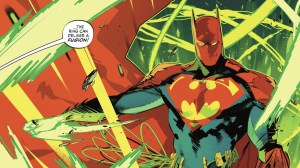Strange Brigade is a game that nails many of the best parts of a cooperative experience, and while it provides a thoroughly entertaining playthrough that has enough replay value to keep it in players’ collections, it can’t quite always shake the feeling that there should be something more to it.
Videos by ComicBook.com
Even if you’re not sure what a “rip-roaring” adventure is, you’ll soon find that Strange Brigade fits that description perfectly, one that the developers Rebellion Developments gave the 1930s game. It’s loud, fast, cheesy, and it lets you live out your Indiana Jones fantasies with a cast of interesting characters. New enemies are introduced in a dramatic fashion fitting for the time period the game aims to be in that’ll always make you grin with the alliteration and pun-filled introductions. Ammo and other supplies are plentiful to ensure that there’s always something blowing up or someone in peril in the four-player co-op game to keep the action moving along at a steady pace.
The narrator is perhaps one of the best examples of this aspect of the game, a voice that emphasizes every move you make, even praising you for your acrobatic maneuvers. It’s the same voice that you’ll hear in the game’s story trailer with the narrator sticking with you from start to finish. In the beginning, the narrator’s quips will likely wear on you to the point that you look for ways to quiet the enthusiastic background noise, so Rebellion thoughtfully added an option to set the chatter to different levels of intensity. I found myself leaving it on the max setting to get the full experience though, an outcome in which the narrator was instrumental. He’s quite self-aware as well since he appears to know he’s in a game, thus adding to the cheesiness – he’ll inform you that there’s a pause button if you stop moving for a stretch of time and will say that he’s not going to budge first. There’s even a trophy or achievement if you wait long enough and exhaust his dialogue, though with the trophies not yet fully enabled, we can’t speak to the exact requirements.

Narration aside, the gameplay mechanics Rebellion decided on have turned Strange Brigade into an insanely accessible game that you can pick up and immediately get started with without any preparation. Players’ ammo for their secondary weapons is unlimited, explosives have a cooldown so you never truly run out, and the fact that the only consumable is a health potion means there aren’t any daunting menus and inventories to sift through. The guns that players start with and later unlock with gold are shared between whichever of the four characters you choose to play as, so with everyone having the same possible loadouts with only different amulet powers and default skills to set them apart, you never feel like you’re forced into some meta-dominating role or feel as though you have to play a supportive or defensive character to round out your team.
Amulets in Strange Brigade are the best part of the character customization options and weave the game’s builds and treasure-hunting gameplay together. Throughout Strange Brigade, you’ll find doors and loot locked behind different puzzles that task you with remembering patterns, shooting targets, and directing sources of power from Point A to Point E and everything in between. Hidden behind these puzzles and guarded by traps are piles of gold, gems that augment your guns’ abilities, and relics, the latter being used to fund your amulet purchases. Finding a complete set of six relics awards one “point” that can be spent on a new amulet power, and with each of the four characters boasting four exclusive powers each for a total of 16 amulets, you won’t want to leave any level without unlocking every door to make sure you get to try out all the amulets that you want.
But where the relics shine as one of the better ways of making sure players search every level’s nooks and crannies, the gold glitters far less next to that loot. All the gold you collect funds your weapon purchases with the majority of primary guns locked at the start while two secondary weapons and grenades are also unavailable until purchased. Every weapon’s stats can be previewed before you purchase it, and with the guns falling into the normal categories like shotgun, single-shot rifle, and submachine gun, it’s easy to map out what gun you want to save up for.
Once you get your preferred gun and move onto the other purchases to complete your loadout, there’s little reason to buy another weapon unless you’re just dissatisfied with the one you have or want to try something new. Once you find the one you want and have it upgraded to your liking with life-stealing and recoil-reducing enhancements, those being just some of the effects the gems offer, there’s no pressing reason to spend your gold. This means that once you’re content with your weapons and are set on using one of the 11 primary guns, finding gold in levels is far less appealing or urgent. It’s hard to justify turning back to open that last door when you know the gold won’t help you any longer and you’re staring down the room that’s obviously set up for a boss fight, a situation that noticeably detracts from the later half of the game. In a game where loot and discoveries are so deeply intertwined with the experience, it’s a shame that there aren’t more ways to make use of your gold when playing through the game’s story mode. The puzzles, similarly, could benefit from more diversity as well. They’re relatively easy to complete even if you’re playing solo, though that’s perhaps a positive that lends itself to the accessibility aspect of the game depending on what type of player you are and who you’re adventuring with.

The gunplay itself is fast and loud with rewarding headshots and explosions, but the hitboxes are a frequent frustration. They’re sometimes impressive – in one case, a bullet from a single-shot rifle wizzed between an enemy’s arm and torso and left them unharmed. Rebellion might’ve been going for pinpoint accuracy with this, but it often works against the player. The most basic enemies charge players when they get close and always drift to the left, and while “just aim to the left” is the most obvious advice, it’s a feeling that takes some getting used to and often leaves you feeling like a shot should’ve registered when it missed. Other enemies have specific weak points that some guns such as the single-shot rifle mentioned above struggle to hit which ends up making several bosses and mini-bosses easier to just cheese with explosives instead of fighting them the “proper” way.
Enemy variety in Strange Brigade does help keep players on their toes though with horde-like waves of undead fodder mixed in with mini-bosses and tougher enemy variants. Minotaurs, shielded foes, projectile-slingers, and statues come to life make for a diverse cast of supernatural opponents that the game steadily builds on. It may feel at times like they’ve blended into the forces as just another type of enemy, but reflecting on a fight might leave you surprised at how many split-second decisions you made to adapt to the different enemies that surround you, especially later in the game when you’ve seen most of what there is to see.
Strange Brigade isn’t without its faults, but it’s a co-op game that has its arms wide open to all types of players. All you need to make it through is a character you align with, an amulet to sling enemies around or turn them into chickens, and your trusted weapons with which you’ll fend off the undead. It’s just as easy to play by yourself as it is to go on the rip-roaring adventure with friends, and while you might find yourself left with an unscratched itch for more content and too much gold left in your pockets, it’s worth the time that it offers, especially with the promise of more DLC and free updates later on.
WWG’s Score: 3/5








